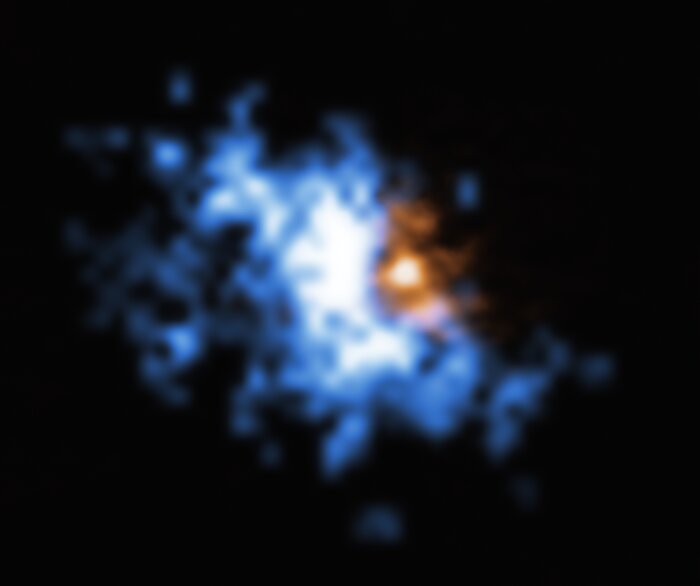Gas halo observed by MUSE surrounding a galaxy merger seen by ALMA
This image shows one of the gas halos newly observed with the MUSE instrument on ESO’s Very Large Telescope superimposed to an older image of a galaxy merger obtained with ALMA. The large-scale halo of hydrogen gas is shown in blue, while the ALMA data is shown in orange.
The halo is bound to the galaxy, which contains a quasar at its centre. The faint, glowing hydrogen gas in the halo provides the perfect food source for the supermassive black hole at the centre of the quasar.
The objects in this image are located at redshift 6.2, meaning they are being seen as they were 12.8 billion years ago. While quasars are bright, the gas reservoirs around them are much harder to observe. But MUSE could detect the faint glow of the hydrogen gas in the halos, allowing astronomers to finally reveal the food stashes that power supermassive black holes in the early Universe.
Credit:ESO/Farina et al.; ALMA (ESO/NAOJ/NRAO), Decarli et al.
About the Image
| Id: | eso1921a |
| Type: | Observation |
| Release date: | 19 December 2019, 12:00 |
| Related releases: | eso1921 |
| Size: | 1852 x 1550 px |
About the Object
| Type: | Early Universe : Galaxy : Activity : AGN : Quasar |
| Constellation: | Capricornus |
| Category: | Cosmology |
Wallpapers
Coordinates
| Position (RA): | 20 32 10.06 |
| Position (Dec): | -21° 14' 2.78" |
| Field of view: | 0.16 x 0.13 arcminutes |
| Orientation: | North is -0.0° left of vertical |
Colours & filters
| Band | Telescope |
|---|---|
| Optical Lyman-alpha | Very Large Telescope MUSE |
| Millimeter CII | Atacama Large Millimeter/submillimeter Array |

